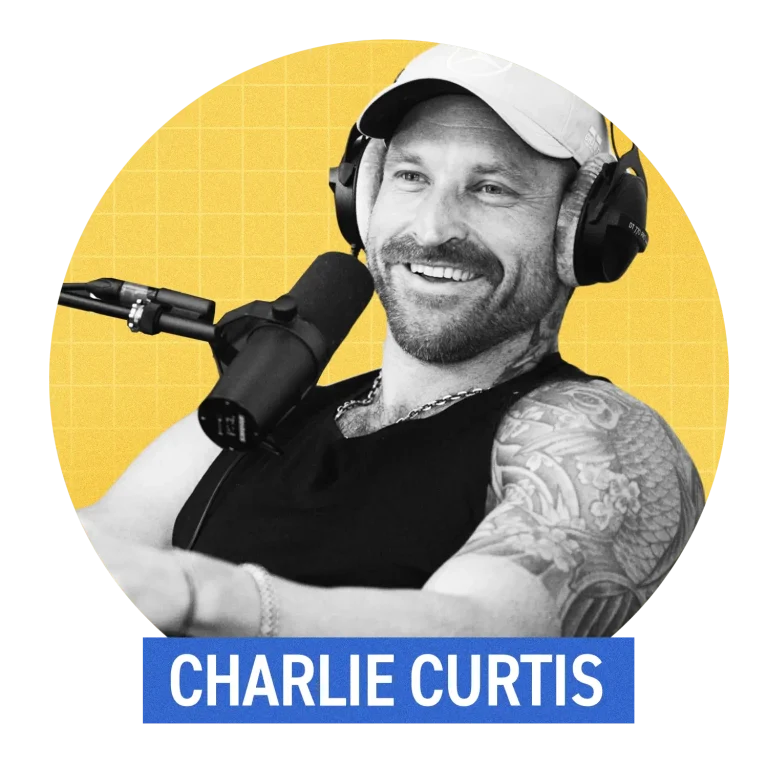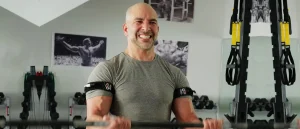5 Tips For Building Muscle After 40, According to a Personal Trainer
- By Sydney Bueckert, NASM C.P.T., C.E.S., F.N.S., G.P.T.S.
- January 2, 2024
Nope, it’s not just you—building muscle after 40 is harder. Anabolic hormone production, tissue regeneration, and signaling processes that trigger muscle growth naturally slow down with age (1, 2, 3). Meaning, whether you’re a little late to the strength training game or building on a routine you’ve had for decades, you probably won’t see results as fast as you did in your 20s.
While some changes are inevitable, training smarter—not harder—can help improve how your body responds to exercise as you age, according to celebrity trainer, Charlie Curtis, NCCPT. Here’s how.
How to tweak your fitness routine as you age for muscle growth, weight loss, performance, and results? Curtis reveals his go-to routine on the Hone In podcast.
About the Expert:
Charlie Curtis is a NCCPT certified personal trainer and founder of the Indoorphins app. Curtis’ no frills approach has helped his clients—like Dax Shepard, Kristen Bell, and Ryan Hansen—build strength, lose weight, and gain energy and confidence through his functional approach to fitness.
Can You Build Muscle After 40?
Yep. Even though gains might come slower as you age, it’s not impossible to build muscle. Consistent strength training in your 40s, 50s, 60s, and beyond can prevent and even reverse the gradual loss of muscle mass, strength, and power that typically kicks in after age 30 (4). In fact, one review published in Sports Medicine found that you can gain strength well into your 70s and 80s (5).
5 Tips for Building Muscle After 40
The fundamentals of building muscle are generally the same at any age, per Curtis. Still, there are a few important tweaks you should make to your strength training plan to reduce muscle soreness, promote recovery, and fast-track results after hitting the big 4-0. Here’s how Curtis breaks it down.
Have a plan
To build muscle, you have to tap into progressive overload—or gradually increasing the stress placed on a muscle group overtime by adding slightly more weight (i.e. five pounds) or volume (i.e. one more rep) each week. “If you’re guessing everytime you go in, you can’t really progressively overload that muscle group, so writing it down and having a plan, I mean, there’s 90 percent of your results right there,” says Curtis.
Curtis’ default plan is to hit 15 working sets per week, per body part—chest, back, biceps, triceps, shoulders, and legs. “Whether it’s a full body day, three days a week or a PPL split, you can break it down however you want; but, you need to get 15 sets in, and they need to be hard—like 90 percent effort,” he says.
As far as movements, Curtis suggests choosing a few exercises for each body part. “For example, you could do five sets of incline bench press one day, two days later you do five sets of bench press, and then five sets of dumbbell flies; and, there’s your 15 sets of chest for the week, easy,” he explains.
Be consistent
“There’s so many magic pills, formulas, and secret sauces that people are trying to market. But at the end of the day, it’s on the individual to work hard and be consistent, that’s really where the magic is,” says Curtis.
If you struggle with consistency, Curtis suggests looking at the big picture: Your results are a weekly, monthly, and yearly average of whatever work you’ve done in that given timeframe. “It’s just a law of averages. You don’t have to be perfect on any one day, you have room to outperform and underperform and still average out to being perfect over the course of a week,” he explains.
Be efficient
Yes, you have to consistently put in work to see results, but don’t over do it. “It’s hard to be consistent when you’re overly sore, and incapacitated,” says Curtis. “The goal should be to feel better and keep progressing.”
Steady progress comes down to being efficient, per Curtis. “You don’t have to spend two and a half hours in the gym to see results, it doesn’t require that,” he says. “You can get just as good results by being consistent and getting your working sets done. You should be in and out of there in an hour.”
Dial in protein
Protein helps with repairing and building muscle after a workout, but we get less efficient at protein synthesis as we age (6). As you hit 40 and beyond, optimizing your protein intake to promote muscle growth is essential. “Even if you eat like crap the rest of the day, prioritizing protein makes a huge difference,” says Curtis.
While the recommended dietary allowance (RDA) for protein is 0.8-1 g/kg of body weight per day, you need more to build muscle—around 1.6-2.2 g/kg (or about 0.75-1.0 g/lb) of body weight per day, according to a review published in Nutrients (7). You’ll also want to spread your protein out throughout the day, if possible, to optimize absorption and keep your body in an anabolic (or muscle building) state (8).
Curtis recommends healthy sources of lean protein like lean meat (chicken, turkey, lean beef) and egg whites to up your intake. He relies on protein shakes to hit his daily protein goals, using two scoops of Ascent protein powder for 50 grams of protein in one hit.
Prioritize recovery
Adequate recovery in between your workouts is essential no matter your age since it’s during this repairing and rebuilding period that your muscles actually grow. But as you get older, recovery becomes even more important since you might not bounce back as fast between workouts.
Make time in your routine for weekly active recovery and periodic deload weeks (where you pare down the intensity) to boost circulation and reduce stress on sore muscles after blocks of hard work. On days and weeks focused on putting the work in, “push within reason,” says Curtis. “If you’re too sore to move, don’t move that day. If you feel really good, got a good night’s sleep, and your energy is high, push a little harder that day. Give your body what it’s giving you every day,” he explains.
If you’re the type of person that thrives by hitting the gym every day, “find a new hobby,” says Curtis. Pick up golf, pickleball, or tennis; do some cardio; but keep it at four to five days in the gym max. “You can’t be in the gym every day. On the other end of obsession is burnout, and all that hard work is completely reversed,” he says.
References
1. Pataky, M. et al. (2022). Hormonal and Metabolic Changes of Aging and the Influence of Lifestyle Modifications.
2. Rando, T. et al. (2021). Regeneration, Rejuvenation, and Replacement: Turning Back the Clock on Tissue Aging.
3. Rivas, D. et al. (2014). Diminished Skeletal Muscle MicroRNA Expression With Aging is Associated with Attenuated Muscle Plasticity and Inhibition of IGF-1 Signaling.
4. Borde, R. et al. (2015). Dose-Response Relationships of Resistance Training in Healthy Old Adults: A Systematic Review and Meta-Analysis.
5. Grgic, J. et al. (2020). Effects of Resistance Training on Muscle Size and Strength in Very Elderly Adults: A Systematic Review and Meta-Analysis of Randomized Controlled Trials.
6. Anisimova, A. et al. (2018). Protein Synthesis and Quality Control in Aging.
7. Stokes, T. et al. (2018). Recent Perspectives Regarding the Role of Dietary Protein for the Promotion of Muscle Hypertrophy with Resistance Exercise Timing.
8. Schoenfeld, B. et al. (2018). How Much Protein Can the Body Use in a Single Meal for Muscle-Building? Implications for Daily Protein Distribution.













